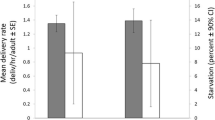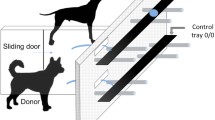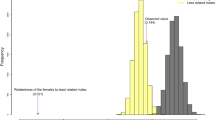Abstract
We examined patterns of affiliation, association, and aggression to inquire whether spotted hyenas (Crocuta crocuta) can distinguish among various groups of maternal and paternal siblings. If so, and if these animals conform to predictions of kin selection theory, then behavioral interactions among hyenas should vary with relatedness. We also considered familiarity-based recognition and phenotype matching as mechanisms hyenas might use to recognize kin. Patterns of affiliative behavior indicated that hyenas favored full-sibling littermates over half-sibling littermates or any other group of half-siblings. Rates of dyadic aggression generally did not vary with kinship. Hyenas associated more closely with half-sibling littermates than with non-littermate half-siblings, and hyenas affiliated more with maternal half-siblings than with paternal half-siblings, suggesting that familiarity-based cues might mediate discrimination among these sibling classes. In addition, operation of a phenotype-matching mechanism was suggested by the preference hyenas demonstrated during affiliative interactions for full- over half-sibling littermates, and by their lack of preference in these interactions for half-sibling littermates over non-littermate half-siblings. Phenotype matching was also suggested by our observation that paternal half-siblings cooperated more, and fought less, than did non-kin. Our data indicate that hyenas can discriminate among various types of siblings, that their social behavior conforms to predictions of kin selection theory, and that they recognize kin using mechanisms of both familiarity and phenotype matching.





Similar content being viewed by others
References
Alberts SC (1999) Paternal kin discrimination in wild baboons. Proc R Soc Lond B 266:1501–1506
Altmann J (1974) Observational study of behavior: sampling methods. Behaviour 49:227–267
Barnard CJ (1990) Kin recognition: problems, prospects, and the evolution of discrimination systems. Adv Stud Behav 19:29–81
Bateson P (1983) Mate choice. Cambridge University Press, Cambridge
Bernstein IS, Ehardt C (1986) The influence of kinship and socialization on aggressive behaviour in rhesus monkeys (Macaca mulatta). Anim Behav 34:739–747
Buchan JC, Alberts SC, Silk JB, Altmann J (2003) True paternal care in a multi-male primate society. Nature 425:179–181
Cairns SJ, Schwager SJ (1987) A comparison of association indices. Anim Behav 35:1454–1469
Dawkins R (1982) The extended phenotype. Freeman, Oxford
East ML, Hofer H (2001) Male spotted hyenas (Crocuta crocuta) queue for status in social groups dominated by females. Behav Ecol 12:558–568
East M, Hofer H, Turk A (1989) Functions of birth dens in spotted hyaenas (Crocuta crocuta). J Zool (Lond) 219:690–697
East ML, Hofer H, Wickler W (1993) The erect ‘penis’ as a flag of submission in a female-dominated society: greetings in Serengeti spotted hyenas. Behav Ecol Sociobiol 33:355–370
East ML, Burke T, Wilhelm K, Grieg C, Hofer H (2003) Sexual conflicts in spotted hyenas: male and female mating tactics and their reproductive outcome with respect to age, social status, and tenure. Proc R Soc Lond B 270:1247–1254
Engh AL, Esch K, Smale L, Holekamp KE (2000) Mechanisms of maternal rank ‘inheritance’ in the spotted hyaena, Crocuta crocuta. Anim Behav 60:323–332
Engh AL, Funk SM, Van Horn RC, Scribner KT, Bruford MW, Libants S, Szykman M, Smale L, Holekamp KE (2002) Reproductive skew among males in a female-dominated mammalian society. Behav Ecol 13:193–200
Fletcher DJC, Michener CD (1987) Kin recognition in animals. Wiley, Chichester
Frank LG (1986a) Social organization of the spotted hyaena (Crocuta crocuta). I. Demography. Anim Behav 34:1500–1509
Frank LG (1986b) Social organization of the spotted hyaena (Crocuta crocuta). II. Dominance and reproduction. Anim Behav 34:1510–1527
Frank LG, Glickman SE, Powch I (1990) Sexual dimorphism in the spotted hyaena (Crocuta crocuta). J Zool Lond 221:308–313
Frank LG, Glickman SE, Licht P (1991) Fatal sibling aggression, precocial development, and androgens in neonatal spotted hyaenas. Science 252:702–704
Gompper ME, Wayne RK (1996) Genetic relatedness among individuals within carnivore societies. In: Gittleman JL (ed) Carnivore behavior, ecology, and evolution. Cornell University Press, Ithaca, pp 429–452
Goodnight KF, Queller DC (1999) Computer software for performing likelihood tests of pedigree relationship using genetic markers. Mol Ecol 8:1231–1234
Gouzoules S (1984) Primate mating systems, kin associations, and cooperative behavior: evidence for kin recognition? Yearb Phys Anthropol 27:99–134
Hamilton WD (1964) The genetical evolution of social behavior, I and II. J Theor Biol 7:1–52
Hauber ME, Sherman PW (2001) Self-referent phenotype matching: theoretical considerations and empirical evidence. Trends Neurosci 24:609–616
Hepper PG (1986) Kin recognition: functions and mechanisms: a review. Biol Rev 61:63–93
Hofer H, East M, Sammang I, Dehnhard M (2001) Analysis of volatile compounds in scent-marks of spotted hyenas (Crocuta crocuta) and their possible function in olfactory communication. In: Marchlewska-Koj A, Lepri JJ, Muller-Schwarze D (eds) Chemical signals in vertebrates, vol 9. Kluwer Academic/Plenum, New York, pp 141–148
Holekamp KE, Smale L (1990) Provisioning and food sharing by lactating spotted hyenas, Crocuta crocuta (Mammalia: Hyaenidae). Ethology 86:191–202
Holekamp KE, Smale L, Szykman M (1996) Rank and reproduction in the female spotted hyaena. J Reprod Fertil 108:229–237
Holekamp KE, Cooper SM, Katona CI, Berry NA, Frank LG, Smale L (1997a) Patterns of association among female spotted hyenas (Crocuta crocuta). J Mammal 78:55–74
Holekamp KE, Smale L, Berg R, Cooper SM (1997b) Hunting rates and hunting success in the spotted hyena (Crocuta crocuta). J Zool (Lond) 242:1–15
Holekamp KE, Boydston EE, Szykman M, Graham I, Nutt KJ, Birch S, Piskiel A, Singh M (1999a) Vocal recognition in the spotted hyaena and its possible implications regarding the evolution of intelligence. Anim Behav 58:383–395
Holekamp KE, Szykman M, Boydston EE, Smale L (1999b) Association of seasonal reproductive patterns with changing food availability in an equatorial carnivore, the spotted hyaena (Crocuta crocuta). J Reprod Fertil 116:87–93
Holmes WG (1986a) Identification of paternal half-siblings by captive Belding’s ground squirrels. Anim Behav 34:321–327
Holmes WG (1986b) Kin recognition by phenotype matching in female Belding’s ground squirrels. Anim Behav 34:38–47
Holmes WG, Sherman PW (1982) The ontogeny of kin recognition in two species of ground squirrels. Am Zool 22:491–517
Holmes WG, Sherman PW (1983) Kin recognition in animals. Am Sci 71:46–55
Hoogland JL (1982) Prairie dogs avoid extreme inbreeding. Science 215:1639–1641
Hunte W, Horrocks JA (1987) Kin and non-kin interventions in the aggressive disputes of vervet monkeys. Behav Ecol Sociobiol 20:257–263
Jeugd HP van der, van der Veen IT, Larsson K (2002) Kin clustering in barnacle geese: familiarity or phenotype matching? Behav Ecol 13:786–790
Kareem AM, Barnard CJ (1982) The importance of kinship and familiarity in social interactions between mice. Anim Behav 30:594–601
Kruuk H (1972) The spotted hyena: a study of predation and social behavior. University of Chicago Press, Chicago, Ill.
Lacy RC, Sherman PW (1983) Kin recognition by phenotype matching. Am Nat 121:489–512
Libants S, Olle E, Oswald K, Scribner KT (2000) Microsatellite loci in the spotted hyena Crocuta crocuta. Mol Ecol 9:1433–1449
Marshall TC, Slate J, Kruuk LEB, Pemberton JM (1998) Statistical confidence for likelihood-based paternity inference in natural populations. Mol Ecol 7:639–655
Mateo JM (2002) Kin-recognition abilities and nepotism as a function of sociality. Proc R Soc Lond B 269:721–727
Mateo JM, Johnston RE (2000) Kin-recognition and the ‘armpit effect:’ evidence of self-referent phenotype matching. Proc R Soc Lond B 267:695–700
Meagher TR (1986) Analysis of paternity within a natural population of Chemaelirium luteum. I. Identification of most-likely male parents. Am Nat 128:199–215
Mills MGL (1985) Related spotted hyaenas forage together but do not cooperate in rearing young. Nature 316:61–62
Mills MGL (1990) Kalahari hyaenas: comparative behavioral ecology of two species. Unwin Hyman, London
Petrie M, Krupa A, Burke T (1999) Peacock lek with relatives even in the absence of social and environmental cues. Nature 401:155–157
Pfennig DW (1999) Cannibalistic tadpoles that pose the greatest threat to kin are most likely to discriminate kin. Proc R Soc Lond B 266:57–61
Pfennig DW, Sherman PW (1995) Kin recognition. Sci Am 272:68–73
Queller DC, Goodnight KF (1989) Estimating relatedness using genetic markers. Evolution 43:258–275
Rice WR (1989) Analyzing tables of statistical tests. Evolution 43:223–225
Schwagmeyer PL (1988) Ground squirrel kin recognition abilities: are there social and life-history correlates? Behav Genet 18:495–510
Sherman PW (1980) Limits of ground squirrel nepotism. In: Barlow GW, Silverberg J (eds) Sociobiology: beyond nature/nuture. Westview Press, Boulder, Colo.
Sherman PW (1981) Kinship, demography, and Belding’s ground squirrel nepotism. Behav Ecol Sociobiol 8:251–259
Sherman PW, Reeve HK, Pfennig DW (1997) Recognition systems. In: Krebs JR, Davies NB (eds) Behavioral ecology, 4th edn. Blackwell, Oxford, pp 69–96
Silk JB (2002) Kin selection in primate groups. Int J Primatol 23:849–875
Smale L, Holekamp KE, Weldele M, Frank LG, Glickman SE (1995) Competition and cooperation between littermates in the spotted hyaena, Crocuta crocuta. Anim Behav 50:671–682
Smale L, Nunes S, Holekamp KE (1997) Sexually dimorphic dispersal in mammals: patterns, causes, and consequences. Adv Stud Behav 26:181–250
Smith K, Alberts SC, Altmann J (2003) Wild female baboons bias their social behaviour towards paternal half-sisters. Proc R Soc Lond B 270:503–510
Sun L, Muller-Schwarze D (1997) Sibling recognition in the beaver: a field test for phenotype matching. Anim Behav 54:493–502
Szykman M, Engh AL, Van Horn RC, Funk SM, Scribner KT, Holekamp KE (2001) Association patterns among male and female spotted hyenas (Crocuta crocuta) reflect male mate choice. Behav Ecol Sociobiol 50:231–238
Tang-Martinez Z (2001) The mechanisms of kin discrimination and the evolution of kin recognition in vertebrates: a critical re-evaluation. Behav Processes 53:21–40
Thompson EA (1975) The estimation of pairwise relationships. Ann Hum Genet 39:173–188
Tilson RT, Hamilton WJI (1984) Social dominance and feeding patterns of spotted hyaenas. Anim Behav 32:715–724
Van Horn RC, Engh AL, Scribner KT, Funk SM, Holekamp KE (2004a) Behavioral structuring of relatedness in the spotted hyena (Crocuta crocuta) suggests direct fitness benefits of clan-level cooperation. Mol Ecol 13:448–458
Van Horn RC, Wahaj SA, Holekamp KE (2004b) Role-reversed nepotism between sires and cubs in the spotted hyena (Crocuta crocuta). Ethology (in press)
Waldman B (1988) The ecology of kin recognition. Annu Rev Ecol Syst 19:543–571
Waldman B, Adler K (1979) Toad tadpoles associate preferentially with siblings. Nature 282:611–613
Walters JR (1987) Kin recognition in non-human primates. In: Fletcher DJC, Michener CD (eds) Kin recognition in animals. Wiley, Chichester, pp 359–394
Widdig A, Nurnberg P, Krawczak M, Streich WJ, Bercovitch FB (2001) Paternal relatedness and age proximity regulate social relationships among adult female rhesus macaques. Proc Natl Acad Sci USA 98:13769–13773
Widdig A, Nürnberg P, Krawczak M, Streich WJ, Bercovitch F (2002) Affiliation and aggression among adult female rhesus macaques: a genetic analysis of paternal cohorts. Behaviour 139:371–391
Wilson EO (1987) Kin recognition: an introductory synopsis. In: Fletcher DJC, Michener CD (eds) Kin recognition in animals. Wiley, Chichester, pp 7–18
Wu HMH, Holmes WG, Medina SR, Sackett GP (1980) Kin preference in infant Macaca nemestrina. Nature 285:225–227
Zabel CJ, Glickman SE, Frank LG, Woodmansee KB, Keppel G (1992) Coalition formation in a colony of prepubertal spotted hyenas. In: Harcourt AH, de Waal FBM (eds) Coalitions and alliances in humans and other animals. Oxford University Press, Oxford, pp 112–135
Acknowledgements
We thank the Office of the President of Kenya and the Kenyan Ministry for Science, Education and Technology for permission to conduct this research. We also thank the Kenya Wildlife Service, the Narok County Council and the Senior Warden of the Masai Mara National Reserve for their cooperation. This research complies in all respects with the current laws of Kenya. We thank the following individuals for their assistance in the field: N.E. Berry, E.E. Boydston, S.M. Cooper, M. Durham, A.L. Engh, J. Friedman, P. Garrett, I. Graham, T.H. Harty, C.I. Katona, K. Nelson, G. Ording, M. Szykman, K. Weibel, and B. White. We thank L. Smale for her role in data collection and for helpful suggestions during all phases of this research. We thank P. Bills for assistance with extraction of data from archived field notes. The research presented here was described in Animal Research Protocol AUF 02/00-043-00 approved most recently on 24 March 2003 by the All University Committee on Animal Use and Care at Michigan State University. This work was supported by NSF grants IBN9630667, IBN9906445, IBN0113170, and IBN0343381 to K.E.H. and an NSF Graduate Research Fellowship to S.A.W.
Author information
Authors and Affiliations
Corresponding author
Additional information
Communicated by S. Alberts
Rights and permissions
About this article
Cite this article
Wahaj, S.A., Van Horn, R.C., Van Horn, T.L. et al. Kin discrimination in the spotted hyena (Crocuta crocuta): nepotism among siblings. Behav Ecol Sociobiol 56, 237–247 (2004). https://doi.org/10.1007/s00265-004-0783-8
Received:
Revised:
Accepted:
Published:
Issue Date:
DOI: https://doi.org/10.1007/s00265-004-0783-8




